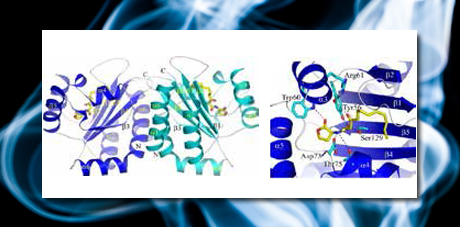
Towards New Cures for Hospital Infections
In this project, a number of small molecules capable of interfering with the quorum sensing (QS) system of Pseudomonas Aeruginosa were synthesized.
Infection caused by bacteria resistant to most common types of antibiotics represents a growing global health problem. Research over the last few decades has shown that development of antibiotic resistance is related to the ability of bacteria to form so-called biofilms. Consisting mainly of an extracellular polysaccharide matrix, the biofilm embeds the bacterial cells and makes it difficult for the immune system as well as antibiotics to eradicate the bacterium. This thesis focuses on the prevention of biofilm formation. More specifically, the project investigates a series of novel, synthetic small molecules for their ability to perturb the intercellular communication system of bacteria related to biofilm formation.
The bacterium Pseudomonas aeruginosa was used as a model organism. P. aeruginosa is a pathogenic bacterium associated with the majority of hospital-aquired infections and patients suffering from cystic fibrosis. The microorganism uses an intercellular communication process termed quorum sensing (QS) to control the formation of drug-resistant biofilm and various virulence factors. The system is regulated by small signaling molecules, referred to as N-acyl homoserine lactones (AHLs).
Recent scientific advances have indicated the possibility of intercepting the QS system by synthetic non-native ligands and thereby lower the pathogenesis and antibiotic tolerance of bacterial biofilms. Furthermore, since QS is not directly involved in biological processes that are essential for bacterial survival, the modulation of the system does not impose selective pressure for the development of resistant mutants.
In this project, a number of small molecules capable of interfering with the QS system were synthesized. Virtual screening of N-dipeptido homoserine lactone libraries against target proteins responsible for QS control in P. aeruginosa identified a number of potential hits. The best hits were then synthesized using a solid-phase strategy, and subsequent biological studies revealed 17 compounds that activate the QS system of P. aeruginosa, with EC50 values in the low micromolar range.
Two “build/couple/pair” strategies for the synthesis of structurally diverse small molecules were developed. In the first strategy, the Petasis 3-component reaction of hydrazides was utilized to rapidly assemble a densely functionalized template. Diversification by “functional group pairing” was then applied to provide a range of cyclized products, thereby providing efficient access to oxazolidinone and oxadiazolone heterocyclic compounds. Ring-closing metathesis of alkene moieties appropriately positioned in Petasis-3CR products yielded a variety of cyclized products. In the second strategy, a number of alkyne- and azide-containing amino acid-derivatives were coupled, and macrocyclic peptidomimetics were obtained after intramolecular ruthenium-catalyzed azide-alkyne cycloadditions.
Many challenges around toxicity and other issues need to be solved before clinical applications of the compounds presented in the thesis can even be considered. However, the small molecules synthesized in this project may serve as chemical probes to provide further knowledge about bacterial QS systems and infectious disease.